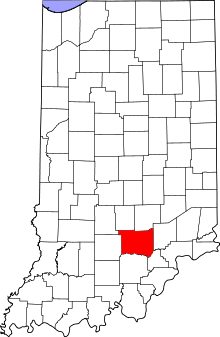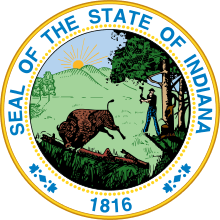Jackson County, Indiana
| Jackson County, Indiana | |
|---|---|
|
Southern face of Jackson County Courthouse in Brownstown | |
 Location in the U.S. state of Indiana | |
 Indiana's location in the U.S. | |
| Founded | Jan 1, 1816 |
| Named for | Andrew Jackson |
| Seat | Brownstown |
| Largest city | Seymour |
| Area | |
| • Total | 513.91 sq mi (1,331 km2) |
| • Land | 509.31 sq mi (1,319 km2) |
| • Water | 4.60 sq mi (12 km2), 0.90% |
| Population | |
| • (2010) | 42,376 |
| • Density | 83/sq mi (32.12/km²) |
| Congressional district | 9th |
| Time zone | Eastern: UTC-5/-4 |
| Website |
www |
| Footnotes: Indiana county number 36 | |
Jackson County is a county located in the U.S. state of Indiana. As of 2010, the population was 42,376.[1] The county seat is Brownstown.[2]
History
Jackson County was formed in 1816. It was named for Andrew Jackson, who defeated the British in 1815 at the Battle of New Orleans in the War of 1812, and afterward elected President of the United States.[3]
Jackson County was the site of the first recorded train robbery of a moving train in the United States. On October 6, 1866 the Reno Gang robbed an Ohio and Mississippi Railway train making off with over $10,000.They were nicknamed: "The Jackson Theives" later on.[4]
Jackson County is home to the longest 3-span covered bridge in the world; The Medora Covered Bridge. After a recent project to completely refurbish the Medora Covered Bridge the nearby town of Medora now has an annual event using the bridge as the focal point. The bridge is open for pedestrian traffic and site-seers. Another long neglected covered bridge, the Bells Ford Bridge, which is believed the last remaining Post Truss bridge in the world, succumbed to similar neglect, collapsing into the White River on January 2, 2006.
Geography
According to the 2010 census, the county has a total area of 513.91 square miles (1,331.0 km2), of which 509.31 square miles (1,319.1 km2) (or 99.10%) is land and 4.60 square miles (11.9 km2) (or 0.90%) is water.[5]
Cities and towns
Townships
Adjacent counties
- Brown County (north-northwest)
- Bartholomew County (north-northeast)
- Jennings County (east)
- Scott County (southeast)
- Washington County (south)
- Lawrence County (west)
- Monroe County (northwest)
Major highways
Sources: National Atlas,[6] U.S. Census Bureau[7]
National protected areas
- Hoosier National Forest (part)
- Muscatatuck National Wildlife Refuge (part)
Climate and weather
| Brownstown, Indiana | ||||||||||||||||||||||||||||||||||||||||||||||||||||||||||||
|---|---|---|---|---|---|---|---|---|---|---|---|---|---|---|---|---|---|---|---|---|---|---|---|---|---|---|---|---|---|---|---|---|---|---|---|---|---|---|---|---|---|---|---|---|---|---|---|---|---|---|---|---|---|---|---|---|---|---|---|---|
| Climate chart (explanation) | ||||||||||||||||||||||||||||||||||||||||||||||||||||||||||||
| ||||||||||||||||||||||||||||||||||||||||||||||||||||||||||||
| ||||||||||||||||||||||||||||||||||||||||||||||||||||||||||||
In recent years, average temperatures in Brownstown have ranged from a low of 19 °F (−7 °C) in January to a high of 85 °F (29 °C) in July, although a record low of −23 °F (−31 °C) was recorded in January 1977 and a record high of 106 °F (41 °C) was recorded in July 1954. Average monthly precipitation ranged from 2.84 inches (72 mm) in February to 5.01 inches (127 mm) in May.[8]
Government
The county government is a constitutional body, and is granted specific powers by the Constitution of Indiana, and by the Indiana Code.
County Council: The county council is the fiscal body of the county government and controls all the spending and revenue collection in the county. The 7 representatives are elected from 4 county districts and 3 at-large positions. The council members serve four-year terms. They are responsible for setting salaries, the annual budget, and special spending. The council also has limited authority to impose local taxes, in the form of an income and property tax that is subject to state level approval, excise taxes, and service taxes.[9][10]
Board of Commissioners: The executive body of the county is made of a board of commissioners. The commissioners are elected county-wide, in staggered terms, and each serves a four-year term. One of the commissioners, typically the most senior, serves as president. The commissioners are charged with executing the acts legislated by the council, collecting revenue, and managing the day-to-day functions of the county government.[9][10]
Court: The county maintains a small claims court that can handle some civil cases. The judge on the court is elected to a term of six years and must be a member of the Indiana Bar Association. The judge is assisted by a constable who is also elected to a four-year term. In some cases, court decisions can be appealed to the state level circuit court.[10]
County Officials: The county has several other elected offices, including sheriff, coroner, auditor, treasurer, recorder, surveyor, and circuit court clerk Each of these elected officers serves a term of four years and oversees a different part of county government. Members elected to county government positions are required to declare party affiliations and to be residents of the county.[10]
Jackson County is part of Indiana's 9th congressional district and is represented in Congress by Republican Todd Young.[11] It is also part of Indiana Senate districts 44 and 45[12] and Indiana House of Representatives districts 65, 66 and 73.[13]
Demographics
| Historical population | |||
|---|---|---|---|
| Census | Pop. | %± | |
| 1820 | 4,010 | — | |
| 1830 | 4,870 | 21.4% | |
| 1840 | 8,961 | 84.0% | |
| 1850 | 11,047 | 23.3% | |
| 1860 | 16,286 | 47.4% | |
| 1870 | 18,974 | 16.5% | |
| 1880 | 23,050 | 21.5% | |
| 1890 | 24,139 | 4.7% | |
| 1900 | 26,633 | 10.3% | |
| 1910 | 24,727 | −7.2% | |
| 1920 | 24,228 | −2.0% | |
| 1930 | 23,731 | −2.1% | |
| 1940 | 26,612 | 12.1% | |
| 1950 | 28,237 | 6.1% | |
| 1960 | 30,556 | 8.2% | |
| 1970 | 33,187 | 8.6% | |
| 1980 | 36,523 | 10.1% | |
| 1990 | 37,730 | 3.3% | |
| 2000 | 41,335 | 9.6% | |
| 2010 | 42,376 | 2.5% | |
| Est. 2015 | 44,069 | [14] | 4.0% |
| U.S. Decennial Census[15] 1790-1960[16] 1900-1990[17] 1990-2000[18] 2010-2013[1] | |||
As of the 2010 United States Census, there were 42,376 people, 16,501 households, and 11,629 families residing in the county.[19] The population density was 83.2 inhabitants per square mile (32.1/km2). There were 18,202 housing units at an average density of 35.7 per square mile (13.8/km2).[5] The racial makeup of the county was 94.5% white, 0.8% Asian, 0.7% black or African American, 0.2% American Indian, 0.1% Pacific islander, 2.4% from other races, and 1.3% from two or more races. Those of Hispanic or Latino origin made up 5.7% of the population.[19] In terms of ancestry, 28.8% were German, 13.1% were American, 12.8% were Irish, and 9.2% were English.[20]
Of the 16,501 households, 33.7% had children under the age of 18 living with them, 54.4% were married couples living together, 10.8% had a female householder with no husband present, 29.5% were non-families, and 24.4% of all households were made up of individuals. The average household size was 2.53 and the average family size was 2.98. The median age was 38.7 years.[19]
The median income for a household in the county was $47,697 and the median income for a family was $53,534. Males had a median income of $38,608 versus $30,030 for females. The per capita income for the county was $21,498. About 7.6% of families and 11.1% of the population were below the poverty line, including 13.7% of those under age 18 and 6.3% of those age 65 or over.[21]
See also
- The Tribune, daily newspaper covering Jackson County
- National Register of Historic Places listings in Jackson County, Indiana
External links
References
- 1 2 "Jackson County QuickFacts". United States Census Bureau. Retrieved 2011-09-25.
- ↑ "Find a County". National Association of Counties. Archived from the original on May 31, 2011. Retrieved 2011-06-07.
- ↑ Gannett, Henry (1905). The Origin of Certain Place Names in the United States. Govt. Print. Off. p. 167.
- ↑ http://www.history.com/this-day-in-history.do?action=VideoArticle&id=51742
- 1 2 "Population, Housing Units, Area, and Density: 2010 - County". United States Census Bureau. Retrieved 2015-07-10.
- ↑ National Atlas Archived December 5, 2008, at the Wayback Machine.
- ↑ U.S. Census Bureau TIGER shape files
- 1 2 "Monthly Averages for Brownstown, Indiana". The Weather Channel. Retrieved 2011-01-27.
- 1 2 Indiana Code. "Title 36, Article 2, Section 3". IN.gov. Retrieved 2008-09-16.
- 1 2 3 4 Indiana Code. "Title 2, Article 10, Section 2" (PDF). IN.gov. Retrieved 2008-09-16.
- ↑ "Conressman Todd Young". House.Gov. Retrieved 2011-05-15.
- ↑ "Indiana Senate Districts". State of Indiana. Retrieved 2011-07-14.
- ↑ "Indiana House Districts". State of Indiana. Retrieved 2011-07-14.
- ↑ "County Totals Dataset: Population, Population Change and Estimated Components of Population Change: April 1, 2010 to July 1, 2015". Retrieved July 2, 2016.
- ↑ "U.S. Decennial Census". United States Census Bureau. Archived from the original on May 11, 2015. Retrieved July 10, 2014.
- ↑ "Historical Census Browser". University of Virginia Library. Retrieved July 10, 2014.
- ↑ "Population of Counties by Decennial Census: 1900 to 1990". United States Census Bureau. Retrieved July 10, 2014.
- ↑ "Census 2000 PHC-T-4. Ranking Tables for Counties: 1990 and 2000" (PDF). United States Census Bureau. Retrieved July 10, 2014.
- 1 2 3 "DP-1 Profile of General Population and Housing Characteristics: 2010 Demographic Profile Data". United States Census Bureau. Retrieved 2015-07-10.
- ↑ "DP02 SELECTED SOCIAL CHARACTERISTICS IN THE UNITED STATES – 2006-2010 American Community Survey 5-Year Estimates". United States Census Bureau. Retrieved 2015-07-10.
- ↑ "DP03 SELECTED ECONOMIC CHARACTERISTICS – 2006-2010 American Community Survey 5-Year Estimates". United States Census Bureau. Retrieved 2015-07-10.
 |
Monroe County | Brown County and Bartholomew County |  | |
| Lawrence County | |
Jennings County | ||
| ||||
| | ||||
| Washington County | Scott County |
Coordinates: 38°55′N 86°02′W / 38.91°N 86.04°W

